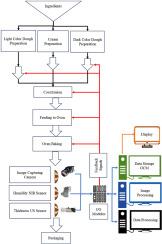Real-time quality analysis of baked goods using advanced technologies
IF 5.3
2区 农林科学
Q1 ENGINEERING, CHEMICAL
引用次数: 0
Abstract
Some critical quality variables of baked goods baked in tunnel ovens cannot be monitored in real-time and quickly after baking. Generally, these variables are measured individually and manually. Analysis of some variables can be done in laboratory environments. It is very difficult to continuously and accurately read the quality variables of products, especially at the exits of industrial tunnel ovens operating at high speeds. With current systems, important quality variables of the products are assessed through widely spaced sampling, and most of the time the measurements made do not represent the entire batch. Additionally, interventions in the process may be delayed due to the time required for analysis, allowing defective products to reach consumers. In this study, experiments were carried out to enable real-time and high-speed identification of important quality variables such as product geometry, surface color, image features, and moisture. The developed system aims to monitor products such as cookies, cakes, biscuits, crackers and bread. Through this system, the size of the products that can represent the lot or even the entire batch can be analyzed when desired. Thus, quality oscillations can be kept within very narrow ranges. The developed hybrid system is applied to the exit of tunnel ovens, and the data read through sensors and cameras are transferred to computers using specially developed algorithms through interfaces. It has been observed that process control signals can also be generated by considering the lower and upper control limits of quality variables. With the developed software, changes can be instantly seen on the screens in the form of graphics, audio, and visual warnings can be created, historical data can be recorded, and reports can be obtained. At the end of the study, it was found that important quality variables such as circularity, diameter, thickness, color, image area, and moisture could be read with a sample size of up to 100%. As a result of the experiments, it was seen that the change in product diameters could be defined within the range of 40.30±0.5 mm. The circularity ratio between horizontal and vertical diameters can be monitored within 1.008 ± 0.018%. The change in moisture within the range of 2.741±0.164 g/100g. The light-dark image area ratios within the range of 0.486±0.033%, and the product thickness within the range of 11.56±0.178 mm. Resultly, all critical quality parameters taken into account can be detected within a range that will not affect product and process quality.

利用先进技术对烘焙食品进行实时质量分析
在隧道炉中烘焙的烘焙食品的一些关键质量变量无法在烘焙后进行实时和快速监测。一般来说,这些变量都是通过人工单独测量的。某些变量的分析可在实验室环境中完成。要连续、准确地读取产品的质量变量非常困难,尤其是在高速运转的工业隧道炉的出口处。在现有的系统中,产品的重要质量变量是通过间隔很大的取样来评估的,而且大多数情况下所做的测量并不能代表整批产品。此外,由于分析所需的时间,对流程的干预可能会被延迟,使有缺陷的产品流入消费者手中。在这项研究中,我们进行了实验,以实现对产品几何形状、表面颜色、图像特征和水分等重要质量变量的实时和高速识别。开发的系统旨在监测饼干、蛋糕、饼干、薄脆饼干和面包等产品。通过该系统,可以根据需要对代表批量甚至整个批次的产品尺寸进行分析。因此,可以将质量波动控制在非常小的范围内。开发的混合系统应用于隧道炉的出口,通过传感器和摄像头读取的数据通过接口以专门开发的算法传输到计算机。据观察,考虑到质量变量的下限和上限控制,还可以生成过程控制信号。利用开发的软件,可以在屏幕上以图形、音频和视觉警告的形式即时看到变化,记录历史数据,并获得报告。研究结束时发现,圆度、直径、厚度、颜色、图像面积和水分等重要质量变量的读取样本量可达 100%。实验结果表明,产品直径的变化范围为 40.30±0.5 毫米。水平直径和垂直直径之间的圆度比可在 1.008 ± 0.018% 的范围内进行监测。水分变化在 2.741±0.164 g/100g 范围内。明暗图像面积比在 0.486±0.033% 范围内,产品厚度在 11.56±0.178 mm 范围内。因此,所有关键质量参数都能在不影响产品质量和加工质量的范围内检测出来。
本文章由计算机程序翻译,如有差异,请以英文原文为准。
求助全文
约1分钟内获得全文
求助全文
来源期刊

Journal of Food Engineering
工程技术-工程:化工
CiteScore
11.80
自引率
5.50%
发文量
275
审稿时长
24 days
期刊介绍:
The journal publishes original research and review papers on any subject at the interface between food and engineering, particularly those of relevance to industry, including:
Engineering properties of foods, food physics and physical chemistry; processing, measurement, control, packaging, storage and distribution; engineering aspects of the design and production of novel foods and of food service and catering; design and operation of food processes, plant and equipment; economics of food engineering, including the economics of alternative processes.
Accounts of food engineering achievements are of particular value.
 求助内容:
求助内容: 应助结果提醒方式:
应助结果提醒方式:


